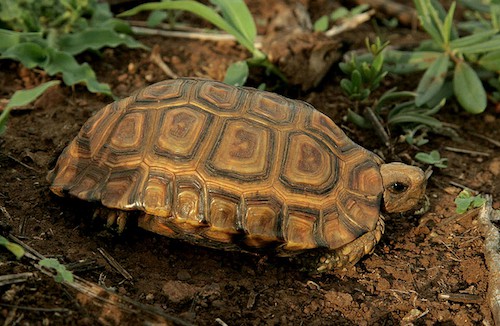| Place of Origin and Range |
Its natural range extends from northern Angola, throughout the Congo basin, as far east as the shores of Lake Victoria, and throughout the West African forests as far as Senegal. Specifically, it is found in Angola, Burkina Faso, Cameroon, Central African Republic, Republic of the Congo, Democratic Republic of the Congo, Ivory Coast, Equatorial Guinea, Gabon, Gambia, Ghana, Guinea, Liberia, Nigeria, Rwanda, Senegal, Sierra Leone, Uganda, possibly Benin, possibly Guinea-Bissau, and possibly Togo. |
| Description |
Potentially the largest of the hinge backs, although it is least commonly seen of the three species. Has a distinct reddish brown coloured carapace with the central areas looking slightly lighter with sunken areas. |
| Morph Patterns Available |
No |
| Adult Size |
Can grow up to 12in(30cm) |
| Accommodation |
They require large enclosures, temperatures above 60 °F (16 °C), and bedding composed of grasses or grass-based hay. Due to their high dietary fibre needs, grasses form a minimum of 75% of their food intake. Including large amounts of clean, fresh water.
|
| Lifespan |
Can live 10+ years |
| Feeding / Diet |
The Hinge-back tortoise are omnivores, feeding on edible leaves, grass, invertebrates, carrion, weeds, and fruits. |
| Other Considerations |
The hingeback tortoise can arch its back 90 degrees downwards to protect its tail and hind legs while sleeping and to protect itself from predators. It is an excellent swimmer and can dive and navigate rainforest water-bodies to search for food. Watch for theses health concerns carefully with your tortoise. Vitamin A Deficiency: Vitamin A is an important nutrient for your tortoise’s health. It is found in his diet in the form of leafy green, orange or yellow vegetables, liver, and fish. If your tortoise is not getting enough Vitamin A, he can suffer serious health problems. Always check to make sure that your tortoise does not have swollen eyelids, as this is the main sign of a Vitamin A deficiency. Also, check for weight loss, nasal discharge and infected skin. Any of these symptoms could point to a deficiency. If you think your tortoise may not be getting enough Vitamin A, you should take him to the veterinarian to get a firm diagnosis. Shell Problems: Your tortoise's shell is very important to his overall health. There are many potential problems that could occur, so you should be on the lookout at all times. Respiratory Disease: Respiratory infections have symptoms similar to vitamin A deficiency, including swollen eyelids and runny nose, so you should take your tortoise to the veterinarian to get a proper diagnosis if you suspect either. More serious infections will be characterized by breathing through the mouth, mucus in the mouth, and wheezing. Always make sure your tortoise’s environment has the proper amount of humidity, as this will help prevent respiratory problems. |




